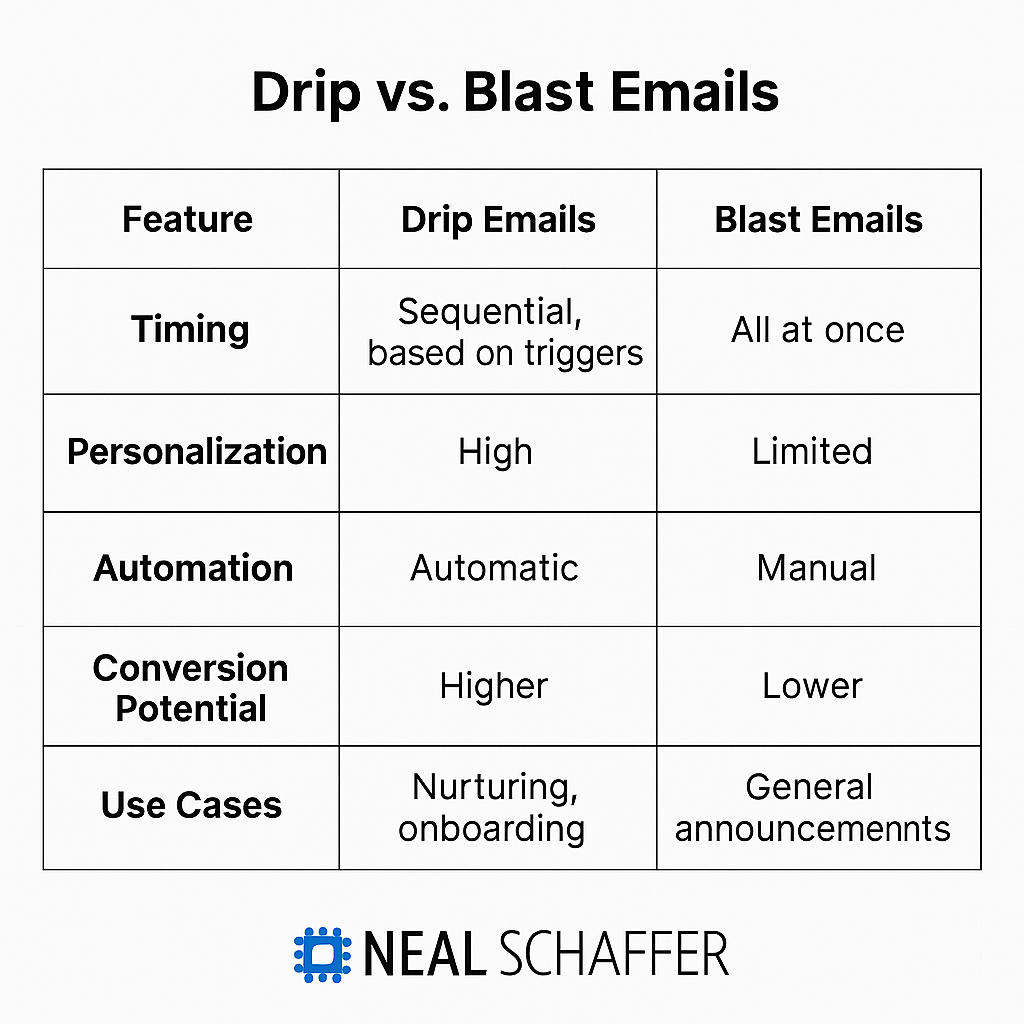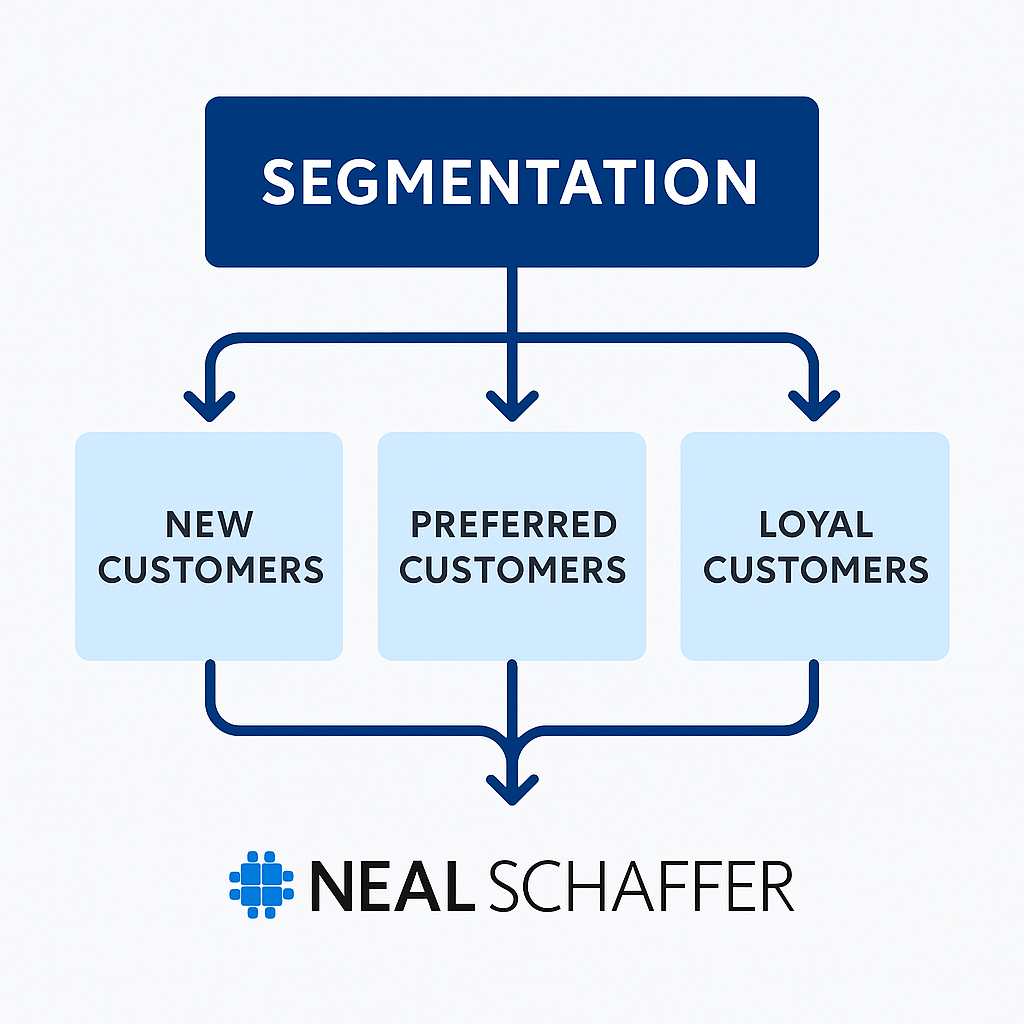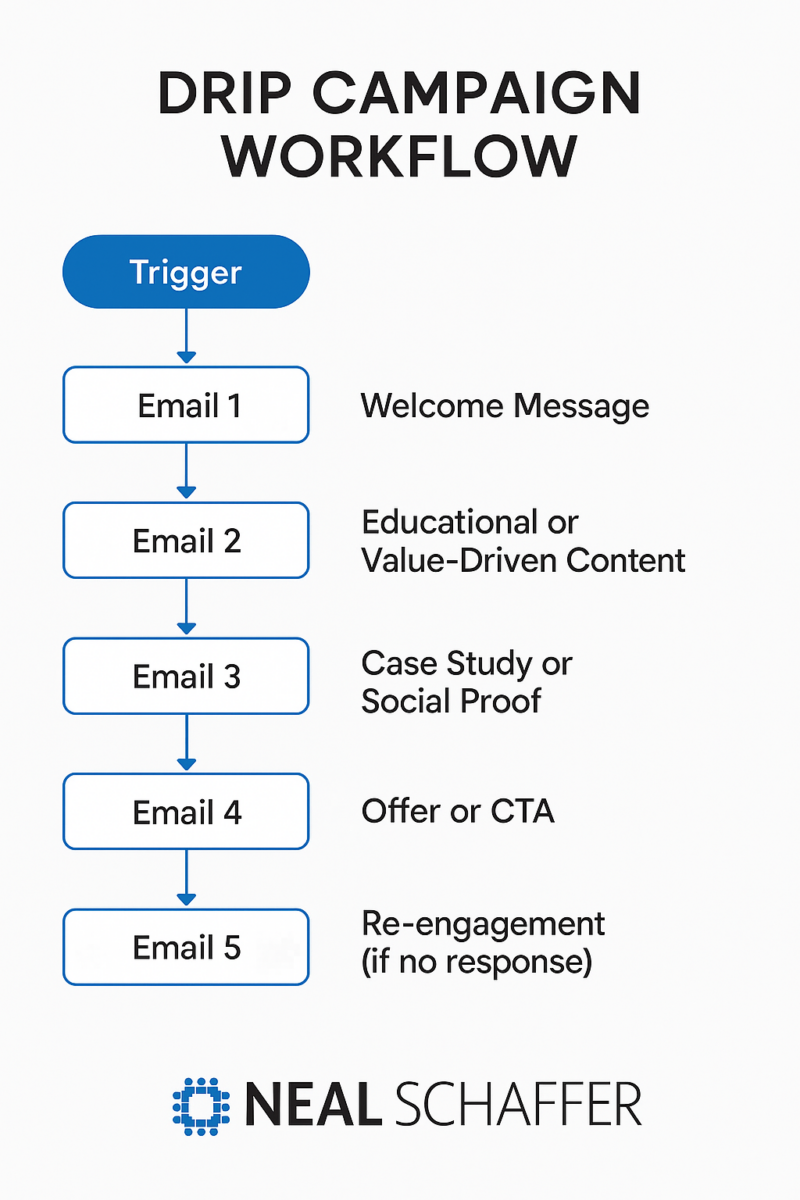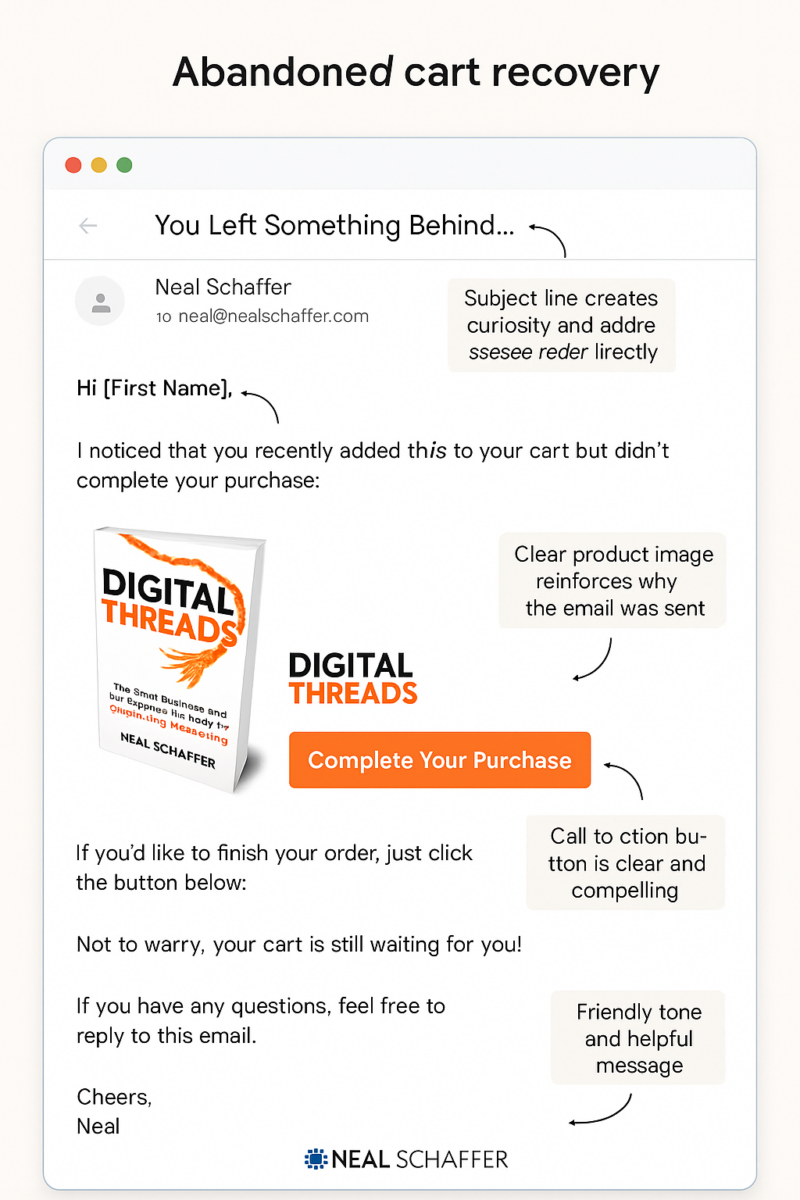
Drip Marketing Explained: How to Build High-Converting Email Campaigns That Work Automatically
Email marketing is all about keeping in better touch with your customers. The bigger and more engaged your list becomes, the more revenue that can be generated for businesses in all industries. But how can you repeatedly engage with your users in an authentic, personalized, and helpful way?
The answer is using a powerful feature of email marketing: Drip Marketing. In this article, I’ll talk about what drip email marketing is, and how it is important. Then, we’ll look at 11 examples of this technique. You can easily use any combination of these drip campaign types to achieve better sales numbers.
What Is Drip Marketing? A Beginner-Friendly Guide to Drip Email Campaigns
You’ve likely heard the phrase “drip marketing” tossed around, especially when it comes to email. But what does it actually mean in the context of modern digital strategy?
At its core, drip marketing is a communication strategy that sends a pre-written set of messages to prospects or customers over time — usually via email, but it can also span across SMS, social media, or even direct mail depending on the campaign. The idea is simple: instead of overwhelming someone with one big marketing blast, you “drip” out email content gradually to your email list, at strategic intervals and natural rates, aligned with where the recipient is in their buyer’s journey.
Drip campaigns are trigger-based — meaning they automatically send emails based on specific user actions, behaviors, or time delays. For example, if someone downloads your free eBook, they might receive a welcome email immediately, a follow-up case study two days later, and a product demo invite a week after that.
To better understand how drip emails differ from traditional email blasts, here’s a quick comparison across key features:

A Brief History of Drip Marketing
The term “drip marketing” originates from the concept of “drip irrigation” in agriculture — a system that delivers small, measured amounts of water over time to help crops grow. Marketers adopted the metaphor in the early 2000s as email automation tools began to evolve, allowing for more tailored, scalable, and time-based communication. What started as simple autoresponders has since evolved into sophisticated multi-touch campaigns powered by behavior tracking and data-driven personalization.
Why Drip Marketing Still Matters Today
With inboxes more crowded than ever, relevance and timing have become the holy grail of effective marketing. That’s exactly what drip email marketing helps you achieve. Instead of pushing out generic messages to your entire list, you create targeted, value-driven sequences that nurture leads, onboard customers, re-engage inactive users, and more.
Drip marketing is particularly powerful because it aligns with how people make decisions — gradually, not all at once. By consistently showing up with helpful, context-aware email content, you build trust, increase conversions, and stay top of mind without being intrusive.
In short, drip marketing isn’t just a tactic — it’s a framework for building meaningful relationships over time, at scale.
How Does It Improve Your Email Marketing?
Drip marketing has many benefits to your overall email marketing efforts. Not only does it give you an opportunity to communicate with the customer, like with transactional emails, but it lets you build a relationship. Once you consider the benefits of email marketing in general, and the boost that drip emails supply, it’ll be easy to know why there’s a superior ROI for email marketing overall.
Improved Automation
One of the things that we marketers often struggle with, especially for small companies, is keeping up with repetitive tasks. However, with drip email marketing, we can “set and forget” at least the bulk of our emails. For instance, if you want to send a “thank you” to every customer that buys something, it’s easy to set up an automatic email for each purchase. Then, you only need to think about potentially rewriting or revising your stock email on occasion, because times do change.
Further Reading: What is Email Marketing Automation and How Much Can You Actually Automate?
Easy Audience Segmentation
Especially if you have a wide range of products, you should segment your email marketing. With drip email campaigns, you can easily send the right message to the right target audience. For instance, a clothing company that sells outfits for men and women could send some messages to the customers that buy men’s clothes, and other emails to those who buy women’s clothes. In the middle, you’ll see households that purchase both lines. Your marketing automation can be set to market the right clothes to the right contacts with minimal effort.
Here’s a simple visual breakdown of how you might segment your audience based on customer status:

Better Audience Engagement
Another benefit of drip marketing is improved audience engagement. Here, I mean interaction with your brand. For instance, the right email campaign will encourage people to view your product and service offerings by clicking through. If you offer a coupon, for instance, customers will often look at the products included in the promotion. And, this is one place where segmentation really works: while it’s impossible to always know which customers want or need a certain product, you’ll have a good idea through browsing habits and other analytics. So, with a segmented email campaign, you can try to match these interests with a promotion.
Likewise, drip email marketing can encourage people to spread the word about a product or service. In some cases, customers will forward an email to their friends or family who might need something. This way, it saves time over simply telling their friend about your products. And as we know, word-of-mouth marketing is a very important aspect of audience engagement.
Stay Top of Mind
Finally, with drip marketing your brand can easily stay top of mind. People don’t think about your brand unless you remind them. And while something as simple as their using your product on a daily basis can help them remember you, it’s important that customers know you are still in business. In addition, you never know when customers will need something. When that happens, you need to be top of mind to get the sale.
Further Reading: 7 Best Practices In Creating Automated and Targeted Email Marketing Campaigns
How to Create a Drip Marketing Campaign: Step-by-Step Strategy for Success
Now that we’ve covered what drip marketing is and why it matters, let’s talk about how to actually put it into practice with a workflow example. Like any effective marketing effort, success with drip campaigns starts with strategy—not software. Here are the key steps to planning and executing a high-impact drip sequence.
Is Your LinkedIn Not Delivering Results?
Just released: my new book to help professionals, entrepreneurs, and business owners maximize LinkedIn for real growth.
With years of LinkedIn expertise, Maximizing LinkedIn for Business Growth offers actionable steps to build your brand, expand your network, and drive results.
Start leveraging LinkedIn like never before—grab your copy now! Click the cover or button below to buy on Amazon.
1. Start with Segmentation
Before you write a single email, you need to know who you’re talking to. Segmentation is the foundation of any successful drip campaign. Think about your audience in terms of behavior, interests, and where they are in the funnel. Are you onboarding new subscribers? Re-engaging lapsed customers? Nurturing leads who downloaded a resource? The more precise your segments, the more relevant your messaging can be.
2. Map the Customer Journey
Every great drip campaign follows a logical path and workflow. Once you’ve identified your audience, sketch out the journey you want to take them on. What action should they take after each email? What questions or objections might they have along the way? This step is where strategy comes into play—your job is to anticipate needs and build momentum through each touchpoint.
Here’s a simple visual example of what a drip email sequence might look like in action:

3. Create Value-Driven Content
Drip marketing campaigns are most effective when they educate, inspire, or solve a problem—not just sell. Each email should have a clear purpose and provide real value. That could be a helpful blog post, a relevant case study, a product demo, or a behind-the-scenes look at your process. Don’t be afraid to mix formats and tones, either. Your audience wants useful content that feels like it was written for them—not a templated sequence.
4. Get the Timing Right
Timing is everything in drip marketing. Too frequent, and you risk annoying your subscribers. Too spread out, and you lose momentum. There’s no perfect rule, but a good starting point is every 2–3 days during a campaign. More important than frequency, though, is context—use time delays and triggers based on actions (like downloads, purchases, or opens) to personalize the timing even further.
5. Choose the Right Automation Tools
Drip campaigns only scale when supported by the right tools. The good news is there are plenty of email marketing platforms—like ConvertKit (which I personally use), ActiveCampaign, Mailchimp, and HubSpot—that make it easy to build, schedule, and track your sequences. Look for a tool that integrates with your CRM, supports behavior-based triggers, and provides analytics so you can optimize over time.
6. Test, Measure, and Improve
No campaign is ever perfect out of the gate. Monitor open rates, click-throughs, and conversion metrics closely. Don’t be afraid to A/B test subject lines, adjust timing, or experiment with content types. Drip marketing is as much about iteration as it is automation.
11 Examples of Drip Marketing to Implement
A lot of email marketing software, with the exception of Drip, of course, doesn’t give you instructions on how to do drip email marketing or even have the term “Drip” in their menus or user interface. That is because the functionality is already built into most major email tools using names like “email sequences” or messages that you send as part of automation. In other words, drip marketing has become so important to email marketing as a whole, that it is ubiquitous.
With that in mind, you might already be doing drip marketing without knowing it, but just in case, here are 11 specific examples of drip email marketing that you should consider adding to your automation today. Depending on your brand and product, some are more important or appropriate than others. For that reason, not every brand needs to do all of these drip marketing types.
1. Welcome Emails
Truth is, most of us send welcome emails. And if you aren’t sending a welcome email when customers sign up for marketing emails, you’re doing it wrong. Welcome emails are simply a “thank you” for subscribing to emails, whether the subscription is a response to a coupon offer, automatic from purchases, or simply spurred by interest. In other words, these emails are sent to each email address once, and never again. They come in a wide variety, from coupons to branded humor and exclusive content.
2. Lead Nurture
Drip email marketing isn’t always about selling right now. Lead nurture emails are intended to keep your brand top of mind for when the time comes. In particular, these emails build brand affinity with a wide variety of methods. For example, a craft or home improvement company might send out tutorials. These tutorials fulfill multiple purposes, such as telling customers what they can do with something they buy. Alternatively, a tutorial can demonstrate to someone that a particular product is a solution to whatever problem they have.
Another example of lead nurturing might be a newsletter. These are very popular with influencers, nonprofits, and creatives. However, traditional for-profit organizations also send out newsletters. In some cases, these include product announcements and changes in key personnel. At the end of the day, the options for lead nurture emails are endless.
3. Abandoned Shopping Carts
Did you know that almost 70% of carts are abandoned? These abandoned shopping carts are especially troubling for e-commerce websites because it means that potential customers have changed their minds about buying something. And, because it’s hard enough to get people to visit an e-commerce site, those “almost” sales should be salvaged if possible.
Getting people who “almost” bought to pull the trigger is the object of abandoned cart emails. And in many ways, this is one of the more valuable drip marketing options, because people who abandon their carts have some interest in your brand. You can take a few different approaches to these emails, including reminders (what are you waiting for) to coupons (here’s an extra reason to buy). Coupons are especially effective when the cost of shipping is high or you are trying to get someone to try your products for the first time.
Further Reading: 9 Types of Transactional Emails Every Marketer Should Know
4. Follow-up Emails to Educate and Onboard Your Target Audience / Tutorials / Tips
After a purchase, customers often enjoy tips and tricks. The same goes after they subscribe to your emails, for whatever reason. One common approach is to send people a link to a tutorial. This can be in conjunction with an influencer marketing campaign where the influencer made a “how-to” video. Or, you could send a manufacturer email that shows people how to operate something.
These follow-ups don’t need to be straight tutorials, though. Some products can be used for things that people don’t initially expect. In this case, you can give people a helpful tip on alternative uses. And finally, tips can touch on ways to, for example, make something work better than it would otherwise. All of these tips are appreciated by people who use certain products.
Further Reading: How to Write Effective Follow-Up Emails
5. Promotions / Limited Offer / Free Trial Campaign
Most of us are very used to these drip email marketing campaigns, especially around holidays. Sometimes the promotion is something simple, like 20% off or buy one, get one. However, not all promotions are this simple. You might talk about a limited offer like a gift with purchase or throwing in free shipping. Finally, free trials are great for subscription services of all types. Ideally, you’ll send segmented promotional emails to your audience because it’ll increase the effectiveness of the campaign.
Further Reading: How to Leverage Ecommerce Email Marketing to Increase Your Sales (with 14 Examples)
6. Re-Engagement
No matter how you cut it, customers are going to “disappear” somewhat regularly. In particular, people will buy from your company once or maybe a few times, then stop. This is where re-engagement emails are useful. This drip marketing technique involves sending a reminder, such as a coupon or other offer, to someone who hasn’t bought for a while. The idea is to get those people to buy things once again. Or at least, let them remember that your brand is still around, so they can recommend you to someone else.
What’s so awesome about re-engagement? Simply put, you can reduce “churn,” or the extent to which you need new customers to replace old ones. While you won’t succeed in recovering a company 100% of the time, you can at least keep more customers than you would otherwise. At the end of the day, this also saves marketing money.
7. Webinars / Events
In this case, the drip email marketing campaign announces your webinars or events. Virtual events are quite useful in our context of reduced travel, and these include webinars. These events can be anything from a discussion of products and services to a more generic industry-wide topic that helps your customers understand more about your business. Similarly, events that you advertise through drip marketing can be online or offline, such as trade shows, conferences, or hobby events.
8. Upsell/ Cross-selling Drips
Just because a customer wants to buy a particular item doesn’t mean it’s the best one for them. Likewise, if somebody buys something, they might find that the item works better if they have something else to go with it. Or, a particular product/service package might be a better value overall than the product someone intends to buy.
Sending an upsell or cross-selling drip email marketing message is one of the best ways to capture this extra money. Customers don’t always realize that there are better options than the ones they might have settled on. Or, they may not realize that they can get the most out of their purchase with a better one. For example, someone might buy a laptop stand without realizing that the stand they’ve chosen works better if they have an external keyboard and mouse. By sending those emails, you get the opportunity to harness more value out of each customer.
9. Purchase Confirmations / Thank You Email
Purchase confirmations are one type of drip marketing you might not think of as marketing. After all, someone who gets these emails has just made a purchase, and you’re mostly sending them the order information. However, these purchase confirmations have some value for marketing because they express gratitude and give a good impression.
10. Renewals
If you have any type of subscription service, this kind of drip marketing is a must. You need to let people know when their subscription will be renewed if nothing else. You can also use this as an opportunity to offer a special deal, like two months free if they pay a whole year in advance. This kind of creativity lets people feel good about renewals and helps you retain customers.
11. Birthday Drip Campaigns
Finally, we have a type of drip email marketing that people love: birthday emails. Many loyalty programs ask members for their birthdays when they join. In addition, some professional services need that information for other reasons. Either way, sending out some birthday cheer, either with gifts and coupons, or just greetings, is a nice gesture. People remember this kind of considerate behavior, even from brands. Plus, they’re often looking to spend money and treat themselves.
Drip Marketing Examples: Real Campaigns from E-commerce, SaaS, and B2B
One of the reasons I’m such a strong advocate of drip marketing is because of its adaptability across industries and business models. Whether you’re selling physical products, offering services, or guiding leads through a longer sales funnel, drip campaigns can be customized to meet your audience exactly where they are.
Here are some examples of how businesses across different sectors are using drip marketing to drive results through sending an automated series of emails:
E-commerce: Abandoned cart campaigns are a staple for online retailers. When someone adds items to their cart but doesn’t check out, a well-crafted drip sequence can bring them back. These emails often include reminders, limited-time discounts, and product reviews. It’s a simple yet powerful way to recover lost sales.
Here’s an example of what an abandoned cart recovery email might look like in practice, using a real product from my own fictional store:

SaaS: Software companies commonly use drip campaigns during free trials. These emails help onboard users, introduce key features, and demonstrate value quickly to increase the chance of conversion. A well-timed sequence can turn a trial user into a long-term customer without overwhelming them.
B2B Services: In the B2B world, where sales cycles are longer and decision-making involves multiple stakeholders, drip marketing helps build trust over time. For example, if someone downloads a whitepaper, you can follow up with a series of emails offering related case studies, insights, and eventually an invitation to schedule a consultation.
Online Education: Drip sequences are highly effective during course launches. A well-structured campaign might warm up your audience with free content, open enrollment with a sense of urgency, and close with testimonials and a final reminder. These campaigns drive engagement and sales by building momentum over time.
These examples show that drip marketing isn’t limited to one type of business or audience. It’s a flexible framework that can help any brand deliver the right message at the right time, consistently and at scale.
Making Drip Marketing Work for Your Business
Drip marketing is more than just a marketing automation tactic. As I write about in Digital Threads, it’s a way to create consistent, personalized, and scalable communication with your audience. By understanding your customers’ journey and meeting them with the right message at the right time, you’re not just marketing—you’re building relationships.
From e-commerce to SaaS to B2B and beyond, drip campaigns are a proven way to nurture leads, onboard users, and re-engage dormant contacts. And the best part? With the right strategy in place, much of it runs automatically, allowing you to stay top-of-mind without needing to be constantly in front of your screen.
If you haven’t yet started using drip campaigns, now is the time. And if you’re already using them, take a fresh look—there’s always room to improve segmentation, refine your messaging, and tighten up your timing. Done right, drip marketing can become one of your most efficient and effective tools for growing your business.









